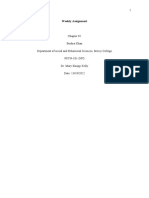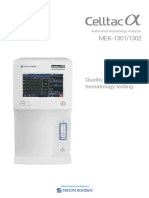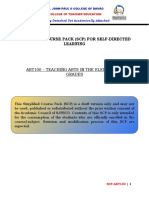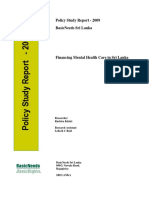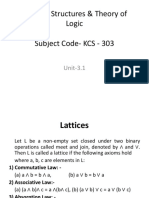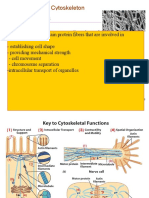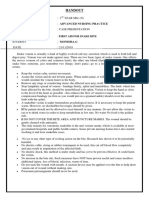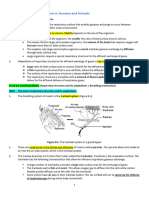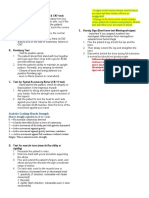Life Sciences Dictionary
Life Sciences Dictionary
Uploaded by
Sdw3sh10 RSACopyright:
Available Formats
Life Sciences Dictionary
Life Sciences Dictionary
Uploaded by
Sdw3sh10 RSAOriginal Description:
Original Title
Copyright
Available Formats
Share this document
Did you find this document useful?
Is this content inappropriate?
Copyright:
Available Formats
Life Sciences Dictionary
Life Sciences Dictionary
Uploaded by
Sdw3sh10 RSACopyright:
Available Formats
COPYRIGHT RESERVED 1
LIFE SCIENCES DICTIONARY / BIOLOGICAL TERMS FOR GRADE 12
1 Nucleotide The building blocks (or monomers) of nucleic acid.
2 DNA Replication The process during which a DNA molecule makes an exact copy (replica)
3 Interphase The phase of meiosis through which DNA replication takes place.
4 DNA Replication Doubles the genetic material so it can be shared between the resulting daughter cells.
5 DNA Replication Results in the formation of identical daughter cells during mitosis.
6 DNA profile An arrangement of black bars representing DNA fragments of the person.
7 Protein synthesis The process by which proteins are made in each cell of an organism.
8 mRNA A bar code pattern formed from DNA
9 Peptide bond The bonds formed between amino acids
10 Hydrogen bond The bonds formed between two nitrogen bases.
11 Nuclear pore Openings in the nuclear membrane that allow mRNA to leave the nucleus
12 Hypothesis A tentative explanation of a phenomenon that can be tested
13 Biogeography The distribution of species in different parts of the world
14 Albinism The condition that results from the absence of skin pigmentation
14 Karyotype The complete set of chromosomes in the cell of an organism
16 Clone A copy of an organism that is genetically identical to the original organism
17 Cloning The process through which a copy of an organism that is genetically identical is formed.
18 Codon The nitrogen base triplets on the mRNA.
19 Anticodon The nitrogen base triplet on the tRNA.
20 The structure in the head of a sperm cell that contains enzymes which break down the
Acrosome
membrane surrounding the ovum
21 Meninges The membranes which protect the central nervous system.
22 Parasympathetic system The nervous system which consists of cranial and spinal nerves
23 Gibberellin A plant growth hormone that stimulates seed germination
24 Peripheral nervous system The nervous system which consists of cranial and spinal nerves
LIFE SCIENCE NSC CAPS GRADE 12 DICTIONARY
COPYRIGHT RESERVED 2
25 The outermost extra-embryonic membrane surrounding the embryo acts as a surface
Chorion
for gas exchange.
26 Aldosterone The hormone that regulates the salt concentration in the human body
27 Umbilical vein The blood vessel in the umbilical cord that carries blood rich in oxygen and nutrients
Thyroid stimulating
The hormone inhibited by an increased level of thyroxin
28 hormone/TSH
29 Gestation The period of development of an embryo in the uterus, between fertilisation and birth
30 Recessive allele An allele that does not influence the phenotype when found in the heterozygous
condition.
31 Cloning The production of a genetically identical copy of an organism using biotechnology
32 Gene A section of a DNA molecule that codes for a specific characteristic
33 Theory An explanation for something that has been observed in nature and which can be supported by
facts, laws and tested hypotheses
34 Chromosome The structure that is made up of two chromatids joined by a centromere
35 Non disjunction The defect in cell division that leads to Down syndrome
36 Anaphase I The phase of meiosis during which homologous chromosomes separate and start moving
towards opposite poles
37 Punctuated equilibrium The explanation that species experience long periods without physical change, followed by short
periods of rapid physical change
38 Artificial selection The deliberate breeding of organisms for desirable characteristics selected by humans
39 Genetic engineering The manipulation of the genetic material of an organism to get desired changes
40 Monohybrid cross Only one characteristic or trait is being shown in the genetic cross
41 Hybrid cross Two characteristics or trait shown in the genetic cross
42 Centromere The structure that joins the two halves of a double-stranded chromosome
43 Prophase I The phase in meiosis where crossing over occurs
44 Chromatid One half of a double-stranded chromosome
45 Chiasma point of contact between two chromosomes of a homologous pair during crossing over
46 Daughter chromosome A single-stranded chromosome formed during Anaphase
LIFE SCIENCE NSC CAPS GRADE 12 DICTIONARY
COPYRIGHT RESERVED 3
47 Homologous chromosome A pair of chromosomes, one inherited from each parent, that have the same genes at the same
Locus
48 Transcription Process through which the mRNA makes a copy of the DNA code to form new proteins.
49 Translation The process through which the tRNA brings specific amino acids to the mRNA.
50 Ribosome The site for protein synthesis.
51 Meiosis Cell division whereby a diploid cell undergoes two cell division to form four different cells.
52 Somatic cell All cells in the body other than the sex cell (sperm cell/egg cell)
53 Mitosis Cell division in which a diploid cell undergoes cell division to form two identical cells
54 Diploid A cell with two set of chromosomes.
55 Haploid A cell with a single set of chromosome.
56 Cytokinesis Division of the cytoplasm.
57 Karyokinesis Division of the nucleus.
58 The number, shape and the arrangement of all the chromosomes in a nucleus of a
Karyotype
somatic cell.
59 Autosomes All the chromosomes of an organism other than the sex chromosomes.
60 Gonosome Sex chromosomes (XY or XX)
61 Gametogenesis Process by which sex chromosomes are produced.
62 Spermatogenesis Process by which sperm cells are produced in the testes.
63 Oogenesis The process by which egg cells or ova are produced in the ovary.
64 Fertilization Fusion of the sperm and an egg cell.
65 External fertilization The sperm fertilises the egg cell outside the body of the female usually in water.
66 Internal fertilization Fertilization occurs inside the female’s reproductive organs.
67 Ovipary Reproductive strategy in which eggs are laid and hatching takes place outside the
Female’s body.
68 Vivipary The young develops inside the uterus of the mother after the eggs are fertilised internally.
69 Ovovivipary Young develop from the eggs that are fertilised internally and retained inside the mothers
70 After fertilisation until they hatch.
71 Amniotic egg The embryo protected by the shell of the egg laid by oviparous animals.
LIFE SCIENCE NSC CAPS GRADE 12 DICTIONARY
COPYRIGHT RESERVED 4
80 York sac The structure that provides nutrition to the embryo in an amniotic egg.
81 Allantois Structure for excretion/collects waste from the embryo in an amniotic egg.
Hatchlings/offsprings are usually:
poorly developed on hatching,
82 Altricial development - Eyes are closed,
- Unable feed on their own,
- brain size and intelligence increases a lot after hatching. .
Hatchlings/offsprings are usually:
83
well developed when they hatch,
Precocial development - Eyes are open,
- Able to move,
- Able to feed, brain size and intelligence remains the same throughout their life.
84 Offered through building of nests, protecting the eggs, protecting the young or teaching
Parental care the young.
85 Uterus/womb Carries the embryo during and foetus during pregnancy.
86 Seminal vesicle A gland that produces a nutrient rich fluid that provides energy for the sperm cells.
87 Cowper’s gland Produces mucus that helps with the movement of the sperm.
88 Prostate gland Produces an alkaline fluid that neutralises the acid from the vagina, which would kill the
sperms.
89 Sperm duct/ vas deferens Transport sperms from the epididymis to the urethra.
90 Urethra Transport semen and urine out of the body.
91 Testes Produces sperm cells and the hormone testosterone.
92 Testosterone The hormone responsible for secondary sexual characteristics in males.
93 - connects the ovaries to the uterus,
- transports egg cells from the ovary,
Fallopian tube
- it is the site of fertilisation.
LIFE SCIENCE NSC CAPS GRADE 12 DICTIONARY
COPYRIGHT RESERVED 5
- Inner lining of the uterus place;
94 - Place where the embryo implants and the placenta forms.
Endometrium
94 Ovary - Produces egg cells,
- Secrets progesterone and oestrogen.
96 Cervix - Lower, narrow part of the uterus.
- It stretches to allow the baby through during child birth.
97 - Receives the penis and semen during sexual intercourse,
Vagina
- The passage through which the baby is born.
99 Mucus plug The structure that form on the cervix that prevents entrance of bacteria.
100 Implantation - The process in which the embryo settles on the endometrium and sinks into it,
- Embryo embedded itself in the endometrium
101 Chorion The finger-like structures from the outer membrane formed by the embryo.
102 Amnion The fluid-filled sac enclosing the embryo.
103 Umbilical vein Carries oxygenated blood from the placenta to the embryo.
105 Umbilical artery Carry deoxygenated blood towards the placenta.
107 Progesterone - A hormone that further thickens the endometrium when secreted.
- Inhibits the secretion of FSH
108 Corpus Lateum The structure that releases progesterone during pregnancy.
109 Ovulation The process when the Graafian follicle burst to release the egg cell.
110 Oestrogen The hormone released by new follicles in the ovary.
111 Gene A small portion of the DNA coding for a particular characteristics.
112 Alleles Different forms of genes which occur at the same locus.
113 Genotype Genetic make-up (composition) of an organism.
114 Phenotype The physical appearance of an organism determined by the genotype.
115 Dominant allele The allele that is expressed (shown) in the phenotype eg Tt.
116 Recessive allele - The allele that is masked (not shown) in the phenotype when found in the
heterozygous condition.
LIFE SCIENCE NSC CAPS GRADE 12 DICTIONARY
COPYRIGHT RESERVED 6
- It is only expressed in a homozygous condition eg tt
117 Heterozygous Two different alleles for a particular characteristics eg.Tt
118 Homozygous Two identical allele for a particular characteristics eg. TT or tt
119 A genetic cross between two phenotypically different parents produces offsprings that
Incomplete dominance
are different from both parents but with an intermediate offspring.
120 Complete dominance A genetic cross were the dominant allele masks (blocks) the expression of the
recessive allele.
121 Co-dominance A genetic cross in which both alleles are expressed equally in the phenotype.
122 Multiple alleles More than two alternative forms of genes at the same locus.
123 Sex-linked characteristics Characteristics or trait that are carried on the sex chromosome.
124 Locus The position of gene on the chromosome.
125 Genetic modification Manipulation of a genetic material to get desired changes.
126 Human genome The mapping of exact position of all the genes in all the chromosomes of a human.
127 Haemophilia A sex-linked condition where blood fails to clot properly.
128 Gene mutation Mutations that affect a single or a few base pairs in just a single gene
129 Chromosomal mutations Refer to changes in the normal structure or number of chromosomes.
130 Absence of a protein that make up either the red or green cones/photoreceptors in the
Colour blindness
eye.
131 Albinism Absence of the protein that forms the pigment melanin (that gives the skin colour)
Pedigree diagram / Family
Is used to study the inheritance of the characteristics in a family over generations.
132 tree
133 The process whereby the genes on the DNA are changed , transferred or manipulated
Genetic engineering
To produce a different organism.
134 - Control voluntary actions.
Cerebrum - Receive and interprets sensations from sense organs.
- Centre for higher mental process.
135 Cerebellum - Coordinates all voluntary movements.
- Controls muscle tension to maintain balance.
LIFE SCIENCE NSC CAPS GRADE 12 DICTIONARY
COPYRIGHT RESERVED 7
136 Medulla oblongata - Transmits nerve impulses between the spinal cord and the brain.
- Controls involuntary actions such as heartbeat and breathing.
137 Hypothalamus The control centre for hunger, thirst, sleep, body temperature and emotions.
Connects the right and left hemisphere of the brain- allows communication between
138 Corpus callosum
the two sides of the brain.
139 Sensory (afferent) neuron Transmits impulses from the sense organs or receptors to the spinal cord and brain.
140 Motor (efferent) neuron Transmits impulses from the brain or spinal cord to sense organs or receptors
muscles and glands, the effectors bring about a response.
141 Interneuron (connector) Links the sensory neuron to the motor neuron.
142 Synapse The functional connection between the axon of one neuron, and the dendrites of
another neuron
143 Reflex action A quick automatic action that involves the spinal cord and does not involve the brain.
144 Reflex arc The path along which the impulse is transmitted to bring about a response to a stimuli.
145 Lens Holds the lens in position.
146 Pupil Opening in the eye that allows light to enter the eye.
147 Iris The coloured part of the eye.
148 Aqueous humour Watery fluid that supports the cornea and the front chamber
149 Vitreous humour A jelly-like substance which gives the shape to the lens.
150 Blind spot - The area with no rods and cones;
- Therefore there is no vision at this spot.
151 Optic nerve Carries nerve impulses from the retina to the brain (cerebrum)
152 Biogeography the study of the distribution of species in different parts of the world
153 Species A group similar organism that can interbreed and produce fertile offspring.
154 speciation the formation of new species from existing species.
155 Myelin sheath a layer fat around the axon that prevents the loss of impulse.
156 Dendrites The structures that sends impulse towards the cell body.
157 Axon the structure that sends impulse away from the cell body
LIFE SCIENCE NSC CAPS GRADE 12 DICTIONARY
COPYRIGHT RESERVED 8
158 Astigmatism A condition were the curvature of the lens or cornea is uneven resulting in distorted image.
159 Glomet A device that is used to drain excess fluids from the middle ear.
160 Double Helix The Natural shape of DNA
161 ADH The hormone that regulates the amount of water in the human body
162 Testosterone A hormone responsible for the development of secondary sexual characteristics in males.
167 Oestrogen A hormone responsible for the development of secondary sexual characteristics in females.
168 Foramen magnum a hole in the skull though which the spine joins the skull.
169 Prognathous protruding/having wider jaws
170 Synapse the functional connection between the axon and one neuron and the dendrites of another neuron.
171 Receptor The structure that receives stimulus and converts it into an impulse.
172 Effector A structure which responds to a stimulus.
173 Cataract A condition were the lens becomes cloud and opaque.
174 Accommodation The adjustment of the shape of the lens to see the objects clearly near or far.
175 Pupillary mechanism Regulates the amount of light entering the eye by adjusting the size of the pupil.
176 Short sightedness (Myopia) A condition were near objects can be seen clearly
inability of the lens to become more flat/eyeball is longer than normal
object falls in front of the retina
Cannot see distant objects clearly.
177 Homeostasis A process of maintaining a constant internal environment.
178 Negative feedback Detect changes or imbalances in the internal environment and to restore the balance.
179 Continuous variation variation were there is wide range of phenotype eg shoe size, height or skin colour.
180 Discontinuous variation variation where there is no wide range of phenotype eg blood groups or eye colour.
181 Natural selection the environment or nature is the selective force.
182 Out of Africa hypothesis states that modern humans originated in Africa and then migrated out of Africa.
represents the possible evolutionary relationship among a set of organisms or groups of
183 Phylogenetic tree/ Cradogam/ organisms.
evolutionary tree
184 Homologous Similar structure in different organisms indicating common ancestry.
185 Prognathous Having pointed face because of projecting jaws and nose.
LIFE SCIENCE NSC CAPS GRADE 12 DICTIONARY
COPYRIGHT RESERVED 9
186 Population A group of organism of organisms of the same species that occupy the same habitat.
187 Natural selection only organisms with favourable characteristics survive.
188 Fossils remains of organisms that have existed in the past.
189 Palaeontology The study of remains of organisms that have existed in the past.
190 Australopithecus genus to which little foot, Mrs Ple, Karabo and Taung Child belong.
191 Homo Sapien genus to which the human ancestor belong.
192 Homo Habilis genus to which Homo habilis and Homo erectus belong
193 Variation Genotype and phenotype differences among organisms of the same species.
Measure of the total amount of carbon dioxide emissions of an individual, a defined population or
194 Carbon footprint any company per year.
Access by all people at all the times, to adequate, safe and nutritious food for health and
195 Food security reproductive life.
The group consisting of modern humans, chimpanzees, gorillas and orangutans plus all their
196 Hominid/Hominidae immediate ancestors.
197 Monoculture The act of growing only type of crop over large areas of land year after year.
198 Herbicides Chemical preparation designed to kill plants, especially weeds, or to inhibit their growth.
199 Pesticides Chemical substances used to eliminate the pests.
200 Sustainable The act of using natural resources without destroying the ecological balance.
201 Biological control The use of the natural enemy of a pest to control the pest population.
202 Chemical control The use of chemical substance such as pesticides to control the pest population
203 Base pair linking of nitrogen bases on the complementary strand of the DNA by hydrogen bond
204 Complementary Nitrogenous bases that always pair with each other joined by hydrogen bond in a DNA molecule.
Strand of DNA upon which another strand of DNA is built from during replication or mRNA during
205 Template Transcription
206 Cerebellum Part of the brain that controls coordination of voluntary muscular movement.
207 Cerebrum Part of the brain that interprets sensations.
208 Corpus callosum Part of the brain that separates the left side of the brain.
209 Choroid Layer behind the retina that supplies nutrients and oxygen to the retina.
LIFE SCIENCE NSC CAPS GRADE 12 DICTIONARY
COPYRIGHT RESERVED 10
Area on the retina containing lots of rods and cones, and is responsible for bright light and colour
210 Yellow spot vision.
211 Ciliary muscles Muscles whose contraction and relaxation alters the shape of the lens bring about accommodation.
212 Cochlea spirally coiled portion of the inner ear responsible for the reception of sound.
213 Ciliary body Thickened circular rim of the choroid which contains ciliary muscles.
214 Auditory canal transmits sound waves to the ear drum/tympanum.
215 Gene pool the sum total of all the alleles that are present in a breeding population of a particular species
216 Cranial nerves nerves arising from the brain.
217 Epididymis provide storage and maturation of sperms cells
218 Genome an organism's entire hereditary information (genes) encoded either on the DNA or RNA.
219 Eustachian tube a tube that equalises pressure on either side of the ear drum/ tympanic membrane.
220 Exocrine grand a grand that has its secretions transported by means of ducts
221 Endocrine gland a grand that pours its secretions (hormones) into the blood streams
222 Graafian follicle produced by the primary follicle and contains the egg cell.
223 Melanin Pigment that gives skin its colour.
the process whereby nutrients become highly concentrated in a body of water leading to algae
224 Eutrophication bloom
225 Fixed/controlled variable variables that are controlled so that they do not interfere with the purpose of the investigation
226 Dependent Variable The factor that is influenced by the independent variable (the effect/result of an investigation)
The variable whose influence is tested in an investigation/ the variable that is manipulated in an
227 Independent variable investigation.
228 Hypothesis A propose solution to the problem that is yet to be tested.
The group consisting of modern humans, extinct human species and all our immediate ancestors
229 Hominin (include members of the genera Homo, Australopithecus, Paranthropus and Ardipithecus).
COMPILED BY JERE SF
LIFE SCIENCE NSC CAPS GRADE 12 DICTIONARY
You might also like
- Bio 12 ExamDocument139 pagesBio 12 ExamAndrew AbdelmalekNo ratings yet
- Weekly AssignmentDocument7 pagesWeekly AssignmentBajwa AyeshaNo ratings yet
- Comparative Proteomics Kit I: Protein Profiler Module: Biotechnology ExplorerDocument50 pagesComparative Proteomics Kit I: Protein Profiler Module: Biotechnology ExplorerHidayat FadelanNo ratings yet
- Wellness Policy 2015Document2 pagesWellness Policy 2015api-301953890No ratings yet
- Prone VentilationDocument25 pagesProne VentilationHazel AsperaNo ratings yet
- GuideToBodySense PDFDocument37 pagesGuideToBodySense PDFshrinidhik@gmailcom100% (1)
- Chronic Pain Clinic Patient History SheetDocument4 pagesChronic Pain Clinic Patient History SheetBelal N. MahfouzNo ratings yet
- ACKNOWLEDGEMENTDocument34 pagesACKNOWLEDGEMENTAnamika PoudyalNo ratings yet
- In2Med EndocrinologyDocument25 pagesIn2Med Endocrinologye148659No ratings yet
- Yeast Bubbles - Experiments On Microscopes 4 SchoolsDocument1 pageYeast Bubbles - Experiments On Microscopes 4 SchoolsMark Sherwin MangarinNo ratings yet
- Unit 5 NotesDocument49 pagesUnit 5 Notesbody fayezNo ratings yet
- Interactive Action PotentialsDocument7 pagesInteractive Action PotentialsNESLEY REANNE VILLAMIELNo ratings yet
- MEK 1301 1302 - enDocument4 pagesMEK 1301 1302 - enBio AllianceNo ratings yet
- Biology - RI - Summaries For All Topics (Document Found Publicly Online)Document70 pagesBiology - RI - Summaries For All Topics (Document Found Publicly Online)Sundaravadivel Prabhav (Njc)No ratings yet
- 1.04 - The Skeletal SystemDocument7 pages1.04 - The Skeletal Systemelio pascualNo ratings yet
- Diversity Among Animals WisegotDocument36 pagesDiversity Among Animals WisegotDheera Nand100% (1)
- Ann 202 212 Vle Funaab 2Document80 pagesAnn 202 212 Vle Funaab 2KAWE-EDU CONSULTSNo ratings yet
- Art100 SCPDocument139 pagesArt100 SCPAinarel AutidaNo ratings yet
- Organic Chemistry: KineticsDocument42 pagesOrganic Chemistry: KineticsElinore TeshaNo ratings yet
- Botn 21n - Exercise 12 - Stems and Secondary GrowthDocument17 pagesBotn 21n - Exercise 12 - Stems and Secondary GrowthABIEGAIL LAMBERTNo ratings yet
- Body Systems NotesDocument2 pagesBody Systems NotesAndrea González MercadoNo ratings yet
- MBOTDSE 2.7-Economic BotanyDocument310 pagesMBOTDSE 2.7-Economic BotanyShruti RathodNo ratings yet
- PhyprojDocument16 pagesPhyprojJaskarandeep Singh JugrahNo ratings yet
- Bio DefinitionsDocument22 pagesBio Definitions青木ケイNo ratings yet
- 1 2 Receptor Tyrosine Kinases 2021Document44 pages1 2 Receptor Tyrosine Kinases 2021Bilakovics NoemiNo ratings yet
- AgaricusDocument12 pagesAgaricuskhalid hafazallahNo ratings yet
- Introduction of MetabolismDocument51 pagesIntroduction of MetabolismrahmatNo ratings yet
- Dissertation-Saumya TewariDocument43 pagesDissertation-Saumya Tewari28 Bushra RahmanNo ratings yet
- ULO2 ADocument4 pagesULO2 AKaris DemetriaNo ratings yet
- BIOLOGY A LEVEL Summary of AN ATOMY AND DISSECTION of The TOAD PDFDocument16 pagesBIOLOGY A LEVEL Summary of AN ATOMY AND DISSECTION of The TOAD PDFTendo SharifNo ratings yet
- Incompatibilities - PhysicalDocument5 pagesIncompatibilities - PhysicalestherNo ratings yet
- Emotional IntelligenceDocument5 pagesEmotional IntelligenceKavitha KrishnanNo ratings yet
- Financing Mental Health Care in Sri LankaDocument40 pagesFinancing Mental Health Care in Sri LankajudyjeyakumarNo ratings yet
- Plants People Planet - 2021 - Suriyagoda - Ceylon Cinnamon Much More Than Just A SpiceDocument18 pagesPlants People Planet - 2021 - Suriyagoda - Ceylon Cinnamon Much More Than Just A Spicenic315No ratings yet
- Ta Chong Hu Brand Price ListDocument2 pagesTa Chong Hu Brand Price ListKristoper BallesterNo ratings yet
- Mendel's Laws of InheritanceDocument68 pagesMendel's Laws of Inheritancemr pcNo ratings yet
- BMS531 BMS537 Lab Manual 2022Document33 pagesBMS531 BMS537 Lab Manual 2022Siti Khadijah Binti Abu SaamahNo ratings yet
- Migratory Behaviour in BirdsDocument19 pagesMigratory Behaviour in BirdsSharad PatelNo ratings yet
- Product Guide: Control and Monitoring SolutionsDocument17 pagesProduct Guide: Control and Monitoring SolutionsHashmat Ali0% (1)
- NCM 103 Rle: Far Eastern University - Nicanor Reyes Medical FoundationDocument4 pagesNCM 103 Rle: Far Eastern University - Nicanor Reyes Medical FoundationMarby BalingdanNo ratings yet
- Nutrition in Running - A Recipe Collection - Lily WrightDocument31 pagesNutrition in Running - A Recipe Collection - Lily Wrightapi-660798311No ratings yet
- The Chemical Senses - Taste and SmellDocument28 pagesThe Chemical Senses - Taste and SmellZuri XimenaNo ratings yet
- Nelsons-Cytogenetics ChapterDocument26 pagesNelsons-Cytogenetics ChapterMicah Lou CalambaNo ratings yet
- Fashion Seal Healthcare Garments CatalogDocument13 pagesFashion Seal Healthcare Garments CatalogIndoSurgicalsNo ratings yet
- DSTL Unit 3Document126 pagesDSTL Unit 3Shivaay GaurNo ratings yet
- Proforma Invoice: Vincent MedicalDocument1 pageProforma Invoice: Vincent Medicalbehruz saadatNo ratings yet
- EMERALD TrialDocument13 pagesEMERALD TrialCristian MuñozNo ratings yet
- معظم امراض الدواجن والبط والارانبDocument48 pagesمعظم امراض الدواجن والبط والارانبToha WaheedNo ratings yet
- Cotton Floral BiologyDocument20 pagesCotton Floral BiologyVishal KuntalNo ratings yet
- Newman CV 2022Document7 pagesNewman CV 2022Newman ZivukuNo ratings yet
- Cell Potency: Cell Potency Is A Cell's Ability To Differentiate Into Other Cell TypesDocument9 pagesCell Potency: Cell Potency Is A Cell's Ability To Differentiate Into Other Cell TypesAlmasidesNo ratings yet
- GT 70ADocument204 pagesGT 70AJonny Barcenas HernandezNo ratings yet
- Lipid ChemistryDocument93 pagesLipid ChemistrySanreet RandhawaNo ratings yet
- 1 7 CytoskeletonDocument31 pages1 7 CytoskeletonAditya AgrawalNo ratings yet
- Alkaloids: DR N AhmedDocument23 pagesAlkaloids: DR N AhmedMohammad SamirNo ratings yet
- Tidal EnergyDocument11 pagesTidal Energysanthoshi durgaNo ratings yet
- Difference Between Direct and Compound ReactionDocument29 pagesDifference Between Direct and Compound ReactionシリーズスーパNo ratings yet
- Biology - Course - Haidar RahhalDocument36 pagesBiology - Course - Haidar RahhalFatima SlimNo ratings yet
- NCERT Class 11th Bio - CHAPTER 16 - EXCRETORY PRODUCTS AND THEIR ELIMINATIONDocument12 pagesNCERT Class 11th Bio - CHAPTER 16 - EXCRETORY PRODUCTS AND THEIR ELIMINATIONLukesh SadhNo ratings yet
- Assessment of OrthopedicVersus Neurologic Causes of Gait Change in Dogs and CatsDocument9 pagesAssessment of OrthopedicVersus Neurologic Causes of Gait Change in Dogs and CatsAristoteles Esteban Cine VelazquezNo ratings yet
- Breastfeeding - Anatomy and PhysiologyDocument22 pagesBreastfeeding - Anatomy and PhysiologyGaylinel Bongyad100% (1)
- 68012007015-HR Enus MOTOTRBO DP4800 DP4800e DP4801 DP4801e FULL KEYPAD PORTABLE RADIO USER GUIDE PDFDocument577 pages68012007015-HR Enus MOTOTRBO DP4800 DP4800e DP4801 DP4801e FULL KEYPAD PORTABLE RADIO USER GUIDE PDFlazib koceilaNo ratings yet
- Biological Terms ActivitiesDocument10 pagesBiological Terms ActivitiessakhiletreemzerNo ratings yet
- Eng A EssayDocument1 pageEng A EssayIssei SenpaiNo ratings yet
- Bls Manual TransesDocument16 pagesBls Manual TransesMark ApeladasNo ratings yet
- AP Holosync Solution Booklet Final Digital CompressedDocument64 pagesAP Holosync Solution Booklet Final Digital CompressedIanNo ratings yet
- Dermatomesmyotomes 200902111404Document58 pagesDermatomesmyotomes 200902111404Dimitris VaziourakisNo ratings yet
- Snake BiteDocument1 pageSnake BitemonishaNo ratings yet
- DlcoDocument49 pagesDlcoCristina Radulea100% (1)
- Unit 1 TestDocument5 pagesUnit 1 Testapi-485795043100% (2)
- MLG 2 (Part 1) The Cell Theory and Cell Structure and FunctionsDocument5 pagesMLG 2 (Part 1) The Cell Theory and Cell Structure and FunctionsJohn Tolentino LaronaNo ratings yet
- F4Bio (C8) NotesDocument11 pagesF4Bio (C8) NotesGrace LeeNo ratings yet
- Voice TherapyDocument8 pagesVoice TherapyJoseph100% (1)
- SILACDocument11 pagesSILACMaihafizah Mohd ZahariNo ratings yet
- Viral Diseases - Mechanisms of Microbial InfectionsDocument105 pagesViral Diseases - Mechanisms of Microbial InfectionspolypeptideNo ratings yet
- Calcium MetabolismDocument10 pagesCalcium MetabolismShoaibNo ratings yet
- Drugs in American Society 10Th Edition Full ChapterDocument22 pagesDrugs in American Society 10Th Edition Full Chapterpat.wellman442100% (65)
- 1.5 Blood 2024.8.26Document1 page1.5 Blood 2024.8.26lamwingsun0105No ratings yet
- The Electrooculogram EOGDocument15 pagesThe Electrooculogram EOGVikas PsNo ratings yet
- Psychology Vocab Worksheet Chapter 7Document3 pagesPsychology Vocab Worksheet Chapter 7ppboyNo ratings yet
- EJMCM - Volume 7 - Issue 8 - Pages 4656-4663Document8 pagesEJMCM - Volume 7 - Issue 8 - Pages 4656-4663Abrar HamimNo ratings yet
- Pharmacology MCQsDocument18 pagesPharmacology MCQsjerry garcia50% (2)
- 100 Item Exam On Fundamentals of NursingDocument54 pages100 Item Exam On Fundamentals of NursingYen Valien Cugay100% (1)
- Histogenesis of BoneDocument6 pagesHistogenesis of BoneAlya Putri KhairaniNo ratings yet
- System Earthing: Technical InstituteDocument70 pagesSystem Earthing: Technical InstituteBasudev PatraNo ratings yet
- NEURO - Retdem: A. Testing For Corneal Reflex (CN5 & CN7 Test)Document1 pageNEURO - Retdem: A. Testing For Corneal Reflex (CN5 & CN7 Test)Peter GirasolNo ratings yet
- Learncbse - in-mCQ Questions For Class 10 Science Control and Coordination With AnswersDocument6 pagesLearncbse - in-mCQ Questions For Class 10 Science Control and Coordination With Answers09whitedevil90No ratings yet
- Amputasi Bellow KneeDocument29 pagesAmputasi Bellow KneeFasihul LizanNo ratings yet
- MDS PresentationDocument29 pagesMDS Presentationelsebaie777No ratings yet
- GRE Biology Subject Test (For Test Takers)Document9 pagesGRE Biology Subject Test (For Test Takers)uttam.micro404No ratings yet

